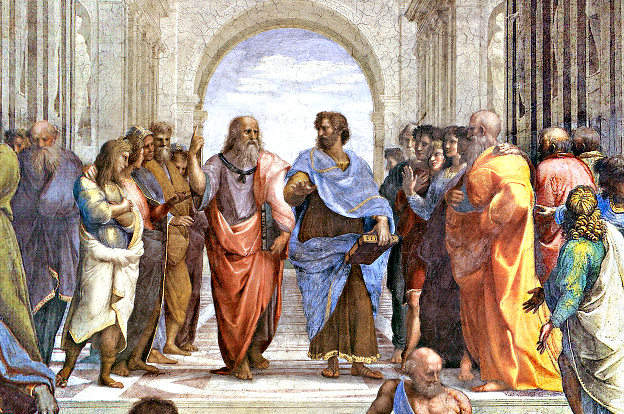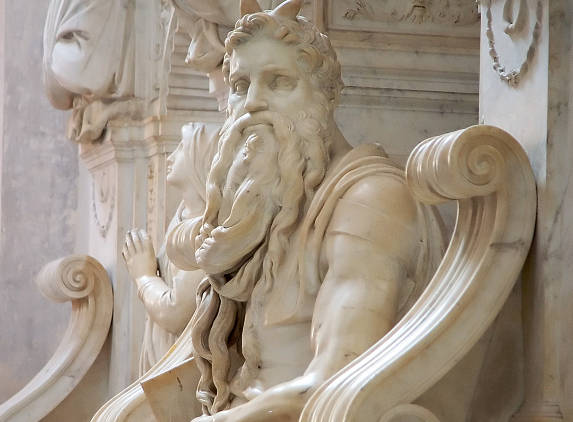|
.:: Ubi's Rome ::.
made in UbiLand |
|
|
Renessaince in Rome II Under Alexander VI, Michelangelo came for the first time in Rome. He was young and he received his first commission in 1946, for a statue of Bacchus in the way of the ancient sculpure, where the god is in his wine-induced inebriation. Soon after was the time of the renowed Pietà (1498-99). This universally known work deserves its fame for the naturalness of the pose and the grace of the bodies (of Christ and Mary). But as for the arts in Rome, it is probably Julius II (Giuliano della Rovere) the best known pope of all, as he lived with the intention of restoring the City and its prestige; financially speaking, his reign was a bitter failure, yet he had some prominent artists to work in Rome: Bramante, Michelangelo and Raphael (Raffaello). Also Baldassarre Peruzzi, a famous architect from Sienna, was operating in Rome at the time. He designed villa della Farnesina (for Agostino Chigi, indeed the original name was Villa Chigi); the building also has frescoes that have probably been produced on original drawings of Raphael (the exact story of the frescoes is not known): this small building on the Lungara is really worth a brief visit! Bramante was already working in Rome and had designed the cloister of di Santa Maria della Pace ("Saint Mary Of Peace", 1500-1504) and the small temple of San Pietro (St. Peter) in Montorio (1502); he was able to realaborate the style of the classic times his own way. He was in charge of connecting the Apostolic Palace with the Belvedere summer residence and in his role as supervisor of the architectonic operations for the Vatican, made possible the re-thinking of the street plan, that included opening via Giulia and the restoration of the via Lungara: today a very interesting place, still with a number of historical buildings and museums in the street and in the sorrounding and leading into the Trastevere district. Bramante also received the job of completely re-designing the Vatican Basilica (St. Peter, in other words). The original building was demolished and the architect took care of rebuilding it according to the new plan. This was not actually fulfilled, but the dome dimesions and the crux pillars remained. Julius II also wanted some new paintings in the Vatican Rooms (his official residence) and made the ceilings be worked by prominent artists such as Sodoma, Johannes Ruysch, Perugino, Bramantino and Lorenzo Lotto. Later, Raffaello Sanzio (Raphael) joined them. It is worth to mention that the rooms already featured paintings by Luca Signorelli and Piero della Francesca. Sadly, the pope liked the art of Raphael so much that he made the old decorations be removed and let the artist lay his own work. Anyway, the universally known "School of Athens" is exactly here, in the "Stanza della Segnatura". Later, Raphael changed his style adding more dynamics and aiming at dramatic effects, some say because of the alternate fortunes of the pope especially in the fights against the French kingdom.  The School of Athens by Raphae; in the center, Plato and Aristoteles Julius II summoned Michelangelo Buonaroti because of his fame, wanting a monumental tumb for himself, inside St. Peter. The story goes that other artists in Rome were so jealous that they set up a plot to distract the pope away from this project, and when Michelangelo came back having already bought marble in Carrara, he was soon forced to get back to Florence, where he had other commissions to fulfill. Julius II later insisted for him to come back and also gave him the task of decorating the Sistine Chapel ("Cappella Sistina") that, as everybody knows, granted him eternal fame in spite of the fact that he was not very skilled in the fresco technique, yet. He carefully planned the execution and soon fired some artists who were intended to help him: in solitude, Michelangelo Buonarroti did most of the work; in 1510, half the chapel was decorated and the artist gained in speed and style. Under Leonis X, son of Lorenzo de' Medici (who gave an unequalled boost to the development of Renaissance art in Florence), Raphael was still immensely appreciated and was appointed responsible for the St. Peter fabrica after the death of Bramante (1514) and, later, he became the supervisor: he now had great experience also in the subjects of sculpture and architecture and he actually also laid the plan of Villa Madama, for cardinal Giulio de' Medici. Meanwhile, Michelangelo was still in charge of building the tumb of Julius II and he gifted humanity with another masterpiece, inclusive of the famous Moses. The artist found a friend in Sebastiano del Piombo and the two found theirselves competing against Raphael when cardinal Giulio de' Medici commissioned two altar pieces for the Narbonne cathedral. Sebastiano del Piombo painted the "Raising of Lazarus", with the main characters drawn by Michelangelo but the setting and colours of Venetian origins. On the other side, Raphael gave birth to its "Transiguration", a work that set a new milestone in the use of light and of scenography in painting.  Michelangelo: the Moses in San Pietro in Vincoli It is paradoxical that one of the most criticized aspects of the Church has always been the wealth of its court, but at the same time such wealth is tied to the artistic production that everybody can enjoy today. Adrian VI (1522-1523), a pope coming from the north of Europe, was contrary to luxury and also to the rich artistic production of his time. With his coming, most artists left Rome for better opportunities, and today we can only thanks the fact that he reigned for a very short time: in his intentions, there was the the erasure of the frescoes in the Sistine Chapel! Clement VII (Julius de' Medici) was elected in 1523 and soon followed the example of his uncled Leonis X. His time was strongly characterized by the recovery of the ancient and "classic" really meant "in fashion". At the time, new artists were emerging, such as Giulio Romano, who soon moved to Mantua and Giovanni Battista Penni, discipules of Raphael. Meanwhile, the death of Rapahel left Sebastiano del Piombo alone as the undisputed portait-maker in Rome. Another name to be remembered is Parmigianino, who created sophisticated works in which the naturalism had great relevance and that best suited the taste of the time. The end of the wonderful season of Reanaissance in Rome abruptely ended in 1527, when most artists left the Ethernal City because of the Sack of Rome, that also had a profound impact on the politics of the time. From a general point of view, we must never forget that the Renaissance had not just been an era of flourishing arts in Rome, but also a time of re-discovery of the classic culture (hence the name "Renaissance", meant as "rebirth"). It is not a case that what we consider to have been the first museum in history (The Capitoline Museum) saw its birth in that period, on the Capitoline Hill (founded in 1471 to display the art collection of Pope Sixtus IV, it can still be visited). |
|
